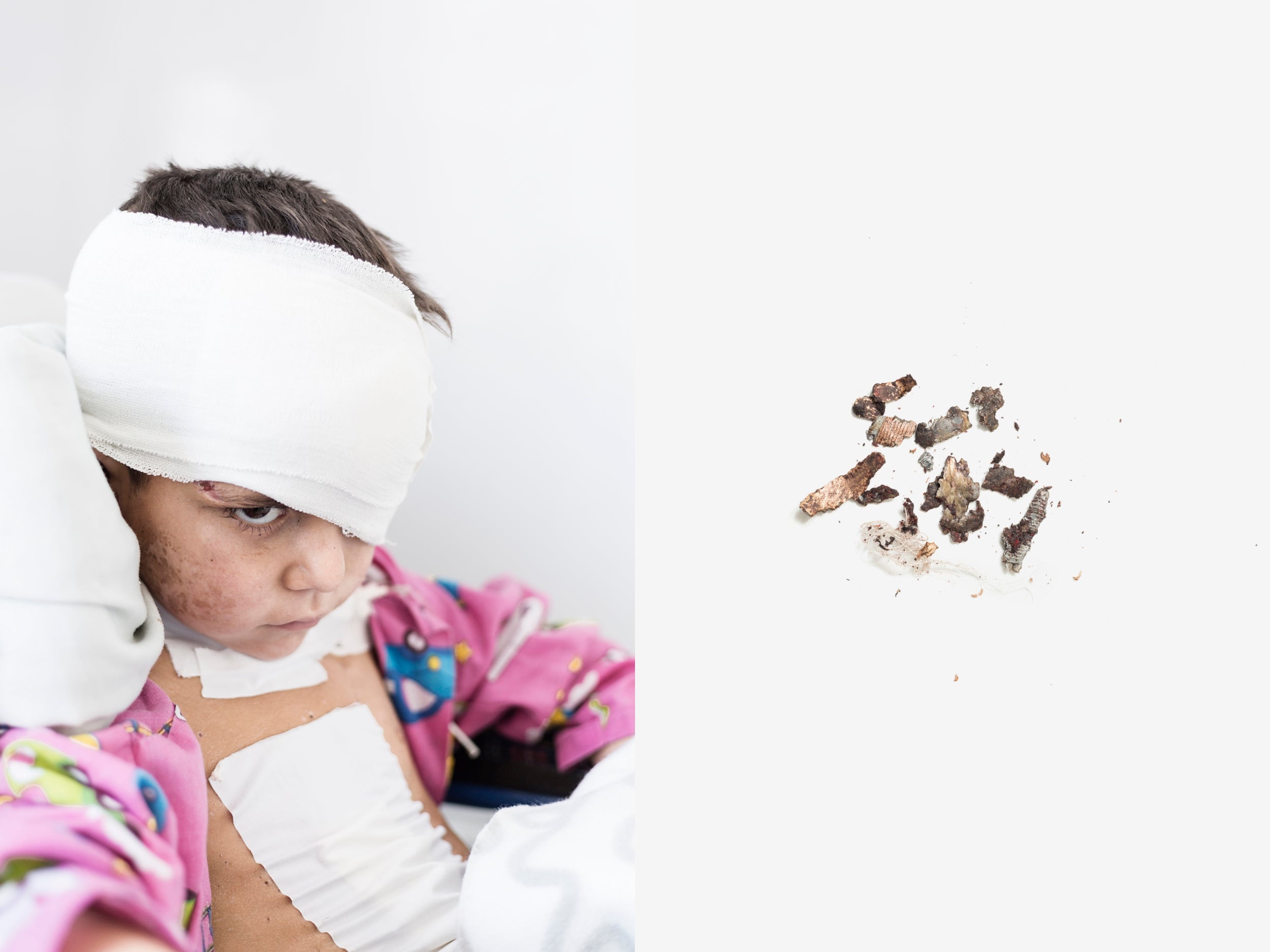When war comes home: the wounds and the 'executioners' of the Afghan conflict
Photographer Giulio Piscitelli visited hospitals in Afghanistan to document the wounds left by the 18-year conflict – and the objects that inflicted them. Emily Goddard reports


Your support helps us to tell the story
From reproductive rights to climate change to Big Tech, The Independent is on the ground when the story is developing. Whether it's investigating the financials of Elon Musk's pro-Trump PAC or producing our latest documentary, 'The A Word', which shines a light on the American women fighting for reproductive rights, we know how important it is to parse out the facts from the messaging.
At such a critical moment in US history, we need reporters on the ground. Your donation allows us to keep sending journalists to speak to both sides of the story.
The Independent is trusted by Americans across the entire political spectrum. And unlike many other quality news outlets, we choose not to lock Americans out of our reporting and analysis with paywalls. We believe quality journalism should be available to everyone, paid for by those who can afford it.
Your support makes all the difference.It was a six-year-old girl in an Afghan hospital that drove home the injustice of war for Italian photographer Giulio Piscitelli. The child had been hit by two bullets, likely from AK-47s, near her home in Helmand. But the shots had been fired from opposing sides – one by an insurgent, the other by Afghan security forces. “It was clear evidence to me that there is no ‘right’ war or violence that can foster peace,” Piscitelli says. “Like George Carlin said, ‘Fighting for peace is like screwing for virginity’ – those that really pay the price of violence are just normal people stuck in the middle of it all.”
Piscitelli was visiting surgical centres in Kabul and Lashkar Gah run by Emergency, an international humanitarian NGO providing free healthcare to victims of war, poverty and landmines, last year when he came across the wounded girl. She is one of the several victims of war that the photographer met as he worked to share the stories of people whose lives have been punctured by 18 years of conflict in Afghanistan.
He had worked in other war zones before but was appalled, that today in a major city like Kabul, there still needs to be a hospital solely dedicated to war wounds. “The world should be ashamed,” Piscitelli says. While he was deeply touched by the manner of the international and local staff at the Emergency hospital, the sheer number of civilians being admitted stunned him. “They hadn’t all been hit by bombs or bullets used in this ‘phase’ of the conflict, but had often been wounded by the endless leftovers of the past: old landmines and unexploded bullets,” Piscitelli explains. “I was really shocked by the legacy of 40 years of war and its consequences, in some ways more so than the current violence in itself.”
Perhaps most alarming is the, predominantly western, notion that war is all but over in Afghanistan. Piscitelli insists it most certainly is not and has become, for some time now, a permanent reality in the nation. “It seems as though there has been a normalisation of the conflict and violence has become an integral part of everyday life,” he says. “It’s important to continue talking about it and not forget the suffering. We risk falling into the same trap with Syria, Palestine and other places; there are so many similar situations.”
The UK Foreign and Commonwealth Office appears to reflect this stance. It says terrorists are “very likely to try to carry out attacks in Afghanistan”. It advises against all but essential travel to an enhanced security zone in Kabul, Hamid Karzai Airport, Panjshir province and the city of Bamian in Bamian province. It advises against all travel to all other areas of Kabul and the rest of Afghanistan.
Yet 141 children who sought refuge in the UK were deported to Afghanistan after turning 18 between January 2015 and September 2018, The Independent revealed earlier this year. Beyond minors, Zainadin Fazlie, a 47-year-old father of four British-born children, was shot dead in his hometown in Maidan Wardak province by Taliban forces after being deported by the British government. He had lived in London with his family for 16 years and had warned of threats to his life before being returned in April 2016.
Piscitelli believes people are not totally indifferent to the suffering of Afghans but worries about the level of attention given to such topics in the media. He suspects we struggle to feel informed and involved in what we read because of the lightning pace of the global news cycle. “This isn’t helped by the fact that the news that arrives from Afghanistan, due to the fact that the violence happens almost daily, has become a constant background noise – just noise in the daily flow of news,” he adds.
On visiting the hospitals, he found victims were keen to share their stories about what had happened to them and show him their wounds. They considered he had a role in exposing the violence they had suffered and that his camera was a good way to convey a message about the atrocities. The result of his trip is a series of compelling images revealing the reality of war for innocent civilians caught in the crossfire – injured children in their teddy-bear pyjamas in hospital beds, wounded young men in an ambulance, a 10-year-old undergoing a rehabilitation session.
Strikingly, some of the images of the survivors are juxtaposed with those of the shrapnel that had caused their injuries. Piscitelli had found the objects were often attached to the patients’ clinical documents and he began to create diptychs that could not only portray the victims, which is the usual approach, but also “the executioners”: showing causes and the effects of the violent situation.
“These objects are one of its faces,” he explains. “The important idea for me was not to shock but to push the observer to reflect on the strong link between the object and the victim. It represents the same relationship between the Afghan people and the strong presence of war in their lives.”
The photos are being brought together to form an exhibition, Zakhem | Wounds: When War Comes Home (zakhem is the translation of wounds in the Dari language), at the Old Truman Brewery on London’s Brick Lane to mark Emergency’s 25th anniversary. During which time, the NGO has treated more than 10 million people, over six million of them in Afghanistan.
‘Zakhem | Wounds: When War Comes Home’ opens at the Old Truman Brewery on Tuesday 5 November and runs until Sunday 10 November
Join our commenting forum
Join thought-provoking conversations, follow other Independent readers and see their replies
Comments